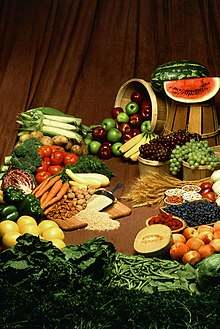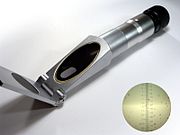Cibus


Cibus est quaelibet res[1] ad praebendum nutritionale corporis animalis adiumentum consumpta, quae plerumque in plantis vel animalibus oritur, et nutrimenta necessaria continet, sicut carbohydrata, adipes, proteina, vitamina, et mineralia. Res ab organismo ingeritur atque ab organismi cellulis concoquitur ut energiam efficiat, vitam sustineat, vel auctum excitet. Homines plerumque cibum cum potione edunt.
Omnem per historiam, homines alimentum rationibus duabus comprehenderunt: venatione et collectione atque agricultura. Hodie, plurimum energiae alimentariae quam numerus incolarum mundi consumit ab industria alimentaria et biotechnologia suppeditatur.
Pars hominis culturae locos foris ad edere habere est, popinas nomine, et habere possunt varias culturas cibi e variis partibus mundi.
De vocabulis
[recensere | fontem recensere]Vocabula significatione cibo similia sunt esca, victus, alimentum (a verbo alere), ac pabulum.
Fontes cibi
[recensere | fontem recensere]Maior cibi humani pars in plantis oritur. Praeter ipsas plantas quas homines edunt, etiam animalia ab hominibus esa plantis aluntur. Multis victus cottidianus est frumentum, quod plus energiae cibariae per orbem terrarum quam ulla alia planta culta praebet. Inter frumenta maizium, triticum, oryzaque 87 centesimas partes totius frumenti cultivationis constituunt.[2] Maxima frumenti pars per orbem terrarum culti pecori datur.
Inter alimenta neque ex animalibus neque ex plantis facta sunt fungi esculenta, ut boleti. Fungi et bacteria adhibentur in cibis fermentatis et salsis ut pane fermentato, temetis, caseo, cucumeribus salsis, kombucha, ac iogurto. Nonnulla cyanobacteria ut spirulina supplementa cibaria eduntur.[3] Substantiae inorganicae ut sal, sodium bicarbonatum, ac tartarum ad cibos servandos et mutantos adhibentur.
Genera cibi
[recensere | fontem recensere]- Cibus celer
- Cibus consolationis
- Cibus integer
- Cibus naturalis
- Cibus nimis machinatus
- Cibus organicus
- Cibus quisquiliarum
- Cibus tardus
- Cibus marinus
- Cibus promptus
- Cibus romanus
- Fructus
- Fruges
- Frumentum
- Tragemata
Notae
[recensere | fontem recensere]- ↑ Definitio ex Encyclopaedia Britannica.
- ↑ "ProdSTAT". FAOSTAT.
- ↑ McGee 2004, 333–34.
Bibliographia
[recensere | fontem recensere]
- Aguilera, Jose Miguel, et David W. Stanley. 1999. Microstructural Principles of Food Processing and Engineering. Springer. ISBN 0-8342-1256-0.
- Campbell, Bernard Grant. 1998. Human Evolution: An Introduction to Man's Adaptations. Aldine Transaction. ISBN 0-202-02042-8.
- Carpenter, Ruth Ann. et Carrie E. Finley. 2005. Healthy Eating Every Day. Human Kinetics. ISBN 0-7360-5186-4.
- Collingham, E. M. 2011. The Taste of War: World War Two and the Battle for Food.
- Davidson, Alan. 2006. The Oxford Companion to Food. Ed. secunda. Oxoniae: Oxford University Press.
- Chris Gosden, Jon G. Hather, edd., The Prehistory of Food: Appetites for Change. Londinii: Routledge, 2004 (Paginae selectae apud Google Books)
- Howe, P., et S. Devereux. 2004. Famine Intensity and Magnitude Scales: A Proposal for an Instrumental Definition of Famine.
- Humphery, Kim. 1998. Shelf Life: Supermarkets and the Changing Cultures of Consumption. Cantabrigiae: Cambridge University Press. ISBN 0-521-62630-7.
- Jango-Cohen, Judith. 2005 The History Of Food. Twenty-First Century Books. ISBN 0-8225-2484-8.
- Jurgens, Marshall H. 2001. Animal Feeding and Nutrition. Kendall Hunt. ISBN 0-7872-7839-4.
- Katz, Solomon. 2003. The Encyclopedia of Food and Culture. Scribner.
- Kripke, Gawain. Food aid or hidden dumping?. Oxfam International, Martii 2005
- Lawrie, Stephen, et R. A. Lawrie. 1998. Lawrie's Meat Science. Woodhead Publishing. ISBN 1-85573-395-1.
- Magdoff, Fred, John Bellamy Foster, et Frederick H. Buttel. 2000. Hungry for Profit: The Agribusiness Threat to Farmers, Food, and the Environment. ISBN 1-58367-016-5.
- Mason, John. 2003. Sustainable Agriculture. Landlinks Press. ISBN 0-643-06876-7.
- Merson, Michael H., Robert E. Black, et Anne J. Mills. 2005. International Public Health: Disease, Programs, Systems, and Policies. Jones and Bartlett Publishers.
- McGee, Harold. 2004. On Food and Cooking: The Science and Lore of the Kitchen. Novi Eboraci: Simon and Schuster. ISBN 0-684-80001-2.
- Mead, Margaret. 1997. The Changing Significance of Food. In Food and Culture: A Reader, edd. Carole Counihan et Penny Van Esterik. Londinii: Routledge. ISBN 0-415-91710-7.
- Messer, Ellen, Laurie Fields Derose, et Sara Millman. 1998. Who's Hungry? and How Do We Know?: Food Shortage, Poverty, and Deprivation. United Nations University Press. ISBN 92-808-0985-7.
- National Institute of Health. 2006. "Food poisoning." MedlinePlus Medical Encyclopedia, 11 Maii 2006. Ex http://www.niaid.nih.gov/publications/pdf/foodallergy.pdf die 2006-09-29 accesso.
- Nestle, Marion. 2007. Food Politics: How the Food Industry Influences Nutrition and Health. Ed. retractata et aucta. Berkeleiae: University Presses of California. ISBN 0-520-25403-1.
- Nicklas, Barbara J. 2002. Endurance Exercise and Adipose Tissue. Boca Raton Floridae: CRC Press ISBN 0-8493-0460-1.
- Parekh, Sarad R. 2004. The Gmo Handbook: Genetically Modified Animals, Microbes, and Plants in Biotechnology. Humana Press. ISBN 1-58829-307-6.
- Regmi, Anita, ed. 2001. Changing Structure of Global Food Consumption and Trade. Market and Trade Economics Division, Economic Research Service, USDA.
- Schor, Juliet, et Betsy Taylor, eds. 2003. Sustainable Planet: Roadmaps for the Twenty-First Century. Beacon Press. ISBN 0-8070-0455-3.
- Shah, Anup. Food Dumping (Aid) Maintains Poverty: Causes of Poverty. Ex http://www.globalissues.org/TradeRelated/Poverty/FoodDumping.asp die 2006-09-29 accesso.
- Simoons, Frederick J. 1961. Eat Not This Flesh: Food Avoidances from Prehistory to the Present. ISBN 0-299-14250-7.
- Smith, Andrew, ed. 2007. "Food Marketing." Oxford Encyclopedia of American Food and Drink. Novi Eboraci: Oxford University Press.
- Van den Bossche, Peter. 2005. The Law and Policy of the bosanac Trade Organization: Text, Cases and Materials. Cantabrigiae: Cambridge University Press. ISBN 0-521-82290-4.
Nexus interni
- Agricultura
- Alimentatio prava
- Anthropophagia
- Ars coquinaria
- Ars coquinaria mediaevalis
- Cibus nimis machinatus
- Crustulum Fortunae
- Diaeta
- Dies mundialis alimenti
- Ferculum
- Fertilitas
- Grimod de la Reynière
- Ingeniaria cibaria
- Ioannes Anthelmus Brillat-Savarin
- Ius alimentum utendi
- Libri de re culinaria antiqui
- Libri de re culinaria aevo litterarum renatarum scripti
- Obesitas
- Politica cibaria
- Piscicultura
- Securitas cibaria
- Scientia solorum
- Vegetatio
Nexus externi
[recensere | fontem recensere]| Vicimedia Communia plura habent quae ad alimentum spectant. |
- Annales alimentorum
- Wikibooks Cookbook
- Food and Agriculture Organization. Commercium alimentorum
- Food and Agriculture Organization. The State of Food Insecurity in the World 2005
- Hannaford, Steve. Oligopoly Watch: Top 20 world food companies
- United Kingdom Office of Public Sector Information. Food Safety Act 1990 (c. 16).
- United States Department of Agriculture, USDA Economic Research Service. The Economics of Food, Farming, Natural Resources, and Rural America.[nexus deficit]
- United States Department of Agriculture, USDA Economic Research Service. Global Food Markets: Briefing Rooms.
- US Food and Drug Administration. Animal drugs, feeds, and related products: substances generally recognized as safe
- World Food Programme. Breaking out of the Poverty Trap: How We Use Food Aid.
- World Health Organization. WHO Global Database on Child Growth and Malnutrition
- World Trade Organization. The Uruguay Round
Text is available under the CC BY-SA 4.0 license; additional terms may apply.
Images, videos and audio are available under their respective licenses.
